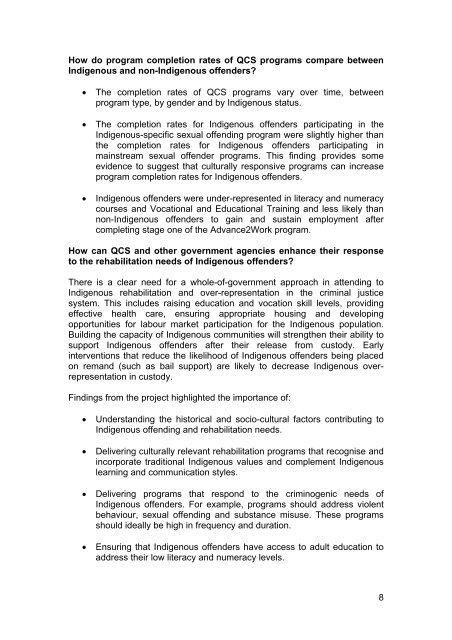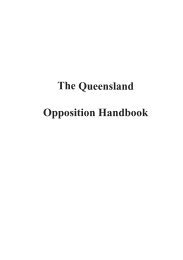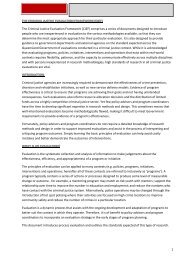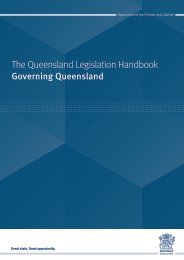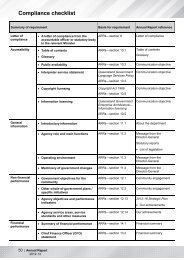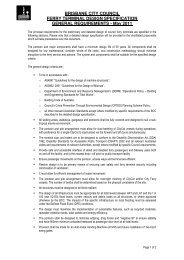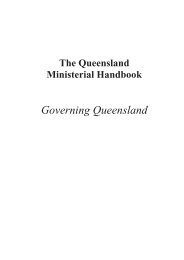Rehabilitative needs and treatment of Indigenous offenders in ...
Rehabilitative needs and treatment of Indigenous offenders in ...
Rehabilitative needs and treatment of Indigenous offenders in ...
You also want an ePaper? Increase the reach of your titles
YUMPU automatically turns print PDFs into web optimized ePapers that Google loves.
How do program completion rates <strong>of</strong> QCS programs compare between<strong>Indigenous</strong> <strong>and</strong> non-<strong>Indigenous</strong> <strong>of</strong>fenders? The completion rates <strong>of</strong> QCS programs vary over time, betweenprogram type, by gender <strong>and</strong> by <strong>Indigenous</strong> status. The completion rates for <strong>Indigenous</strong> <strong>of</strong>fenders participat<strong>in</strong>g <strong>in</strong> the<strong>Indigenous</strong>-specific sexual <strong>of</strong>fend<strong>in</strong>g program were slightly higher thanthe completion rates for <strong>Indigenous</strong> <strong>of</strong>fenders participat<strong>in</strong>g <strong>in</strong>ma<strong>in</strong>stream sexual <strong>of</strong>fender programs. This f<strong>in</strong>d<strong>in</strong>g provides someevidence to suggest that culturally responsive programs can <strong>in</strong>creaseprogram completion rates for <strong>Indigenous</strong> <strong>of</strong>fenders. <strong>Indigenous</strong> <strong>of</strong>fenders were under-represented <strong>in</strong> literacy <strong>and</strong> numeracycourses <strong>and</strong> Vocational <strong>and</strong> Educational Tra<strong>in</strong><strong>in</strong>g <strong>and</strong> less likely thannon-<strong>Indigenous</strong> <strong>of</strong>fenders to ga<strong>in</strong> <strong>and</strong> susta<strong>in</strong> employment aftercomplet<strong>in</strong>g stage one <strong>of</strong> the Advance2Work program.How can QCS <strong>and</strong> other government agencies enhance their responseto the rehabilitation <strong>needs</strong> <strong>of</strong> <strong>Indigenous</strong> <strong>of</strong>fenders?There is a clear need for a whole-<strong>of</strong>-government approach <strong>in</strong> attend<strong>in</strong>g to<strong>Indigenous</strong> rehabilitation <strong>and</strong> over-representation <strong>in</strong> the crim<strong>in</strong>al justicesystem. This <strong>in</strong>cludes rais<strong>in</strong>g education <strong>and</strong> vocation skill levels, provid<strong>in</strong>geffective health care, ensur<strong>in</strong>g appropriate hous<strong>in</strong>g <strong>and</strong> develop<strong>in</strong>gopportunities for labour market participation for the <strong>Indigenous</strong> population.Build<strong>in</strong>g the capacity <strong>of</strong> <strong>Indigenous</strong> communities will strengthen their ability tosupport <strong>Indigenous</strong> <strong>of</strong>fenders after their release from custody. Early<strong>in</strong>terventions that reduce the likelihood <strong>of</strong> <strong>Indigenous</strong> <strong>of</strong>fenders be<strong>in</strong>g placedon rem<strong>and</strong> (such as bail support) are likely to decrease <strong>Indigenous</strong> overrepresentation<strong>in</strong> custody.F<strong>in</strong>d<strong>in</strong>gs from the project highlighted the importance <strong>of</strong>: Underst<strong>and</strong><strong>in</strong>g the historical <strong>and</strong> socio-cultural factors contribut<strong>in</strong>g to<strong>Indigenous</strong> <strong>of</strong>fend<strong>in</strong>g <strong>and</strong> rehabilitation <strong>needs</strong>. Deliver<strong>in</strong>g culturally relevant rehabilitation programs that recognise <strong>and</strong><strong>in</strong>corporate traditional <strong>Indigenous</strong> values <strong>and</strong> complement <strong>Indigenous</strong>learn<strong>in</strong>g <strong>and</strong> communication styles.Deliver<strong>in</strong>g programs that respond to the crim<strong>in</strong>ogenic <strong>needs</strong> <strong>of</strong><strong>Indigenous</strong> <strong>of</strong>fenders. For example, programs should address violentbehaviour, sexual <strong>of</strong>fend<strong>in</strong>g <strong>and</strong> substance misuse. These programsshould ideally be high <strong>in</strong> frequency <strong>and</strong> duration. Ensur<strong>in</strong>g that <strong>Indigenous</strong> <strong>of</strong>fenders have access to adult education toaddress their low literacy <strong>and</strong> numeracy levels.8


